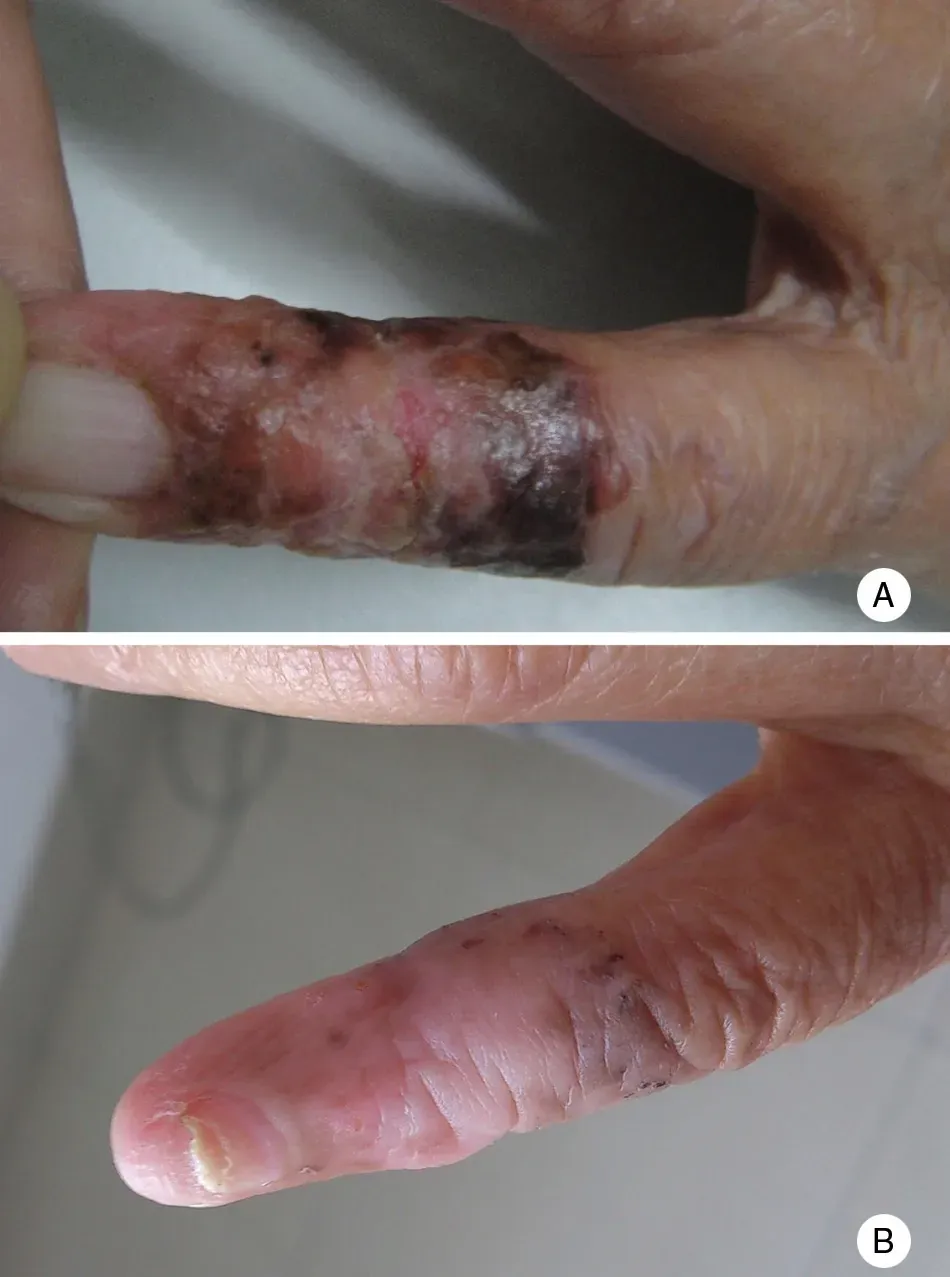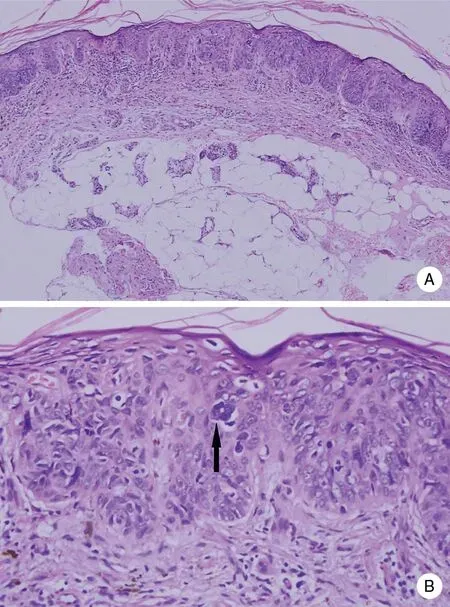Bowen’s Disease on the Left Fifth Finger Successfully Treated with Photodynamic Therapy: A Case Report
Wei-Hong Wu, Maher Al-Muriesh, Xiao-Hong Deng∗, Chang-Zheng Huang∗
1Department of Dermatology, China Resources and WISCO General Hospital, Wuhan, Hubei 430080, China; 2Department of Dermatology, Union Hospital, Tongji Medical College, Huazhong University of Science and Technology, Wuhan, Hubei 430022,China.
Abstract
Keywords: Bowen’s disease, treatment, photodynamic therapy
Introduction
Squamous cell carcinoma in situ is also known as Bowen’s disease(BD).If left untreated,BD may progress to invasive squamous cell carcinoma.1BD typically manifests as slowly enlarging,thin,erythematous plaques with sharply demarcated and irregular borders. BD mainly involves sun-exposed areas; it is more common on the head and neck,but less common in the nail units.2Etiological factors for BD are chronic exposure to ultraviolet radiation,carcinogenic materials, arsenic, immunosuppressive therapies, and infection with human papillomavirus (HPV),especially HPV16,which is associated with genital BD.A variety of modalities have been used to treat BD, such as surgical removal, topical therapy, laser therapy, and photodynamic therapy(PDT),which has been used for the treatment of superficial cancer.3Herein, we presented a case of a 78-year-old woman with BD successfully treated with topical 5-aminolevulinic acid (5-ALA)-PDT, with a better cosmetic outcome.
Case report
A78-year-old woman wasreferredwithaneight-yearhistory of an asymptomatic slowly enlarging lesion on the left fifth finger. A black patch with an erythematous base had appeared on her left fifth finger five years ago.The lesion had subsequently increased in size,and a scale had developed in the center. The surrounding area was covered by a blackbrown patch and crust.The lesion appeared clinically as an erythrosquamous plaque covering two-thirds of the left fifth finger (Fig. 1A). The patient reported no comorbidities,exposure to tar, arsenic, radiation, immunosuppression, or familial history ofanyskin or internal malignancy.Thelesion had persisted despite the intermittent use of antibiotics,steroids,and tacrolimus ointment.

Figure 1. Photographs of the Bowen’s disease lesion before and after treatment with photodynamic therapy.(A)An erythrosquamous scaly plaque with black-brown crusts.(B)An excellent cosmetic result with almost complete clinical clearance of the lesion.
The histological findings of a biopsy sample were consistent with BD (Fig. 2A and 2B). The possible treatment options were explained to the patient, and the patient and her family refused surgical intervention.Due to the location of the lesion and the age of the patient, PDT was performed.The lesion was treated with nine sessions of 5-ALA-PDT,with a one-week interval between sessions.The 5-ALA cream was applied to the lesion and the region surrounding its marginal diameter by 0.5cm. After 3–4 hours,the lesion was irradiated with 635±10nm red light at an intensity of 80mw/cm2for 20 minutes. At three weeks after the final treatment session, the lesion had almost completely disappeared. There were no adverse effects or scarring,although a few hyperpigmented patches remained (Fig. 1B). No recurrence occurred during more than one year of follow-up.The patient was satisfied with the treatment outcome and agreed to publish her case.
Discussion

Figure 2. Histopathological results of the lesion from patient with Bowen’s disease. (A) Image shows hyperkeratosis, parakeratosis,acanthosis, full-thickness keratinocyte atypia with loss of polarity,scattered mitotic figures and dyskeratotic cells, widening of the rete ridges, an intact basal cell layer, and mild lymphocytic infiltrations in the papillary dermis (H&E, ×100). (B) High-powered view shows keratinocyte atypia, mitotic figures, and occasional giant cells(arrowed) (H&E, ×400).
Digital BD is rare. However, in cases of digital BD, the most commonly affected body part in males is the first finger, while the second, third, and fourth fingers of both hands are equally affected in both sexes.A previous study on the distributions of 88 cases of digital BD reported that only one case had polydactyl involvement, including the left fifth finger in a female patient.4Shim et al.5also reported one case of polydactyl BD.It has been suggested that the susceptibility of fingers to trauma might determine the location of digital BD,4,6in addition to the role of HPV in digital BD.
PDT involves the application of a combination of a photosensitizing drug and light to cause selective damage to the target tissue.3Although surgical lesion removal achieves better eradication of BD than PDT, surgical excision is more invasive, as current recommendations suggest that BD should be removed with 0.5cm margins to reduce the incidence of incomplete excision.7However, a previous high-quality study found that PDT is more effective in treating BD than surgical removal and achieves superior cosmetic outcomes.1Furthermore, PDT is more appropriate than surgical excision for large BD lesions and BD lesions located in sites with poor healing ability.Compared with cryotherapy, PDT achieves a similar efficacy and recurrence rate,with better cosmetic outcomes and less destructive effects for HPV-associated lesions.2PDT has been used to successfully treat digital and large BD lesions.8–9PDT is a safe, noninvasive procedure that can be repeated if required, which is an advantage for lesions in older adults or patients who are unwilling to undergo other procedures. Most studies report that PDT only causes mild pain.9PDT reportedly induces severe pain in 10%of all treated patients,moderate pain in 18%,and mild to no pain in 71%.1The present patient experienced mild pain during PDT, with no need for treatment cessation.
In conclusion, PDT appears to be a well-tolerated treatment for older adult patients,and its use is not limited to any particular site.Further studies are needed to assess the use of PDT for the treatment of digital BD and to evaluate its efficacy in treating recurrent BD.
Acknowledgements
This work was supported partially by the grants from the National Natural Science Foundation of China (No. 81472886 and No. 81972565 to HCZ).
- 国际皮肤性病学杂志的其它文章
- Nail Changes as the Initial Sign of Psoriasis:A Case Report
- Tale of Two Alopecias: Alopecia Areata and Central Centrifugal Cicatricial Alopecia Occurring in the Same Patient
- Cutaneous Manifestations and Treatment Advances of Adult T-Cell Leukemia/Lymphoma
- Bullous Pemphigoid: Readability, Quality, and Treatments of Online Health Resources
- Concurrence of Merkel Cell Carcinoma and Squamous Cell Carcinoma in A Patient with Generalized Actinic Keratosis: A Case Report
- Nail Psoriasis: Treatment Options and Management Strategies in Special Patient Populations

